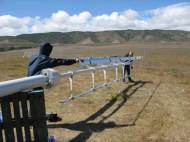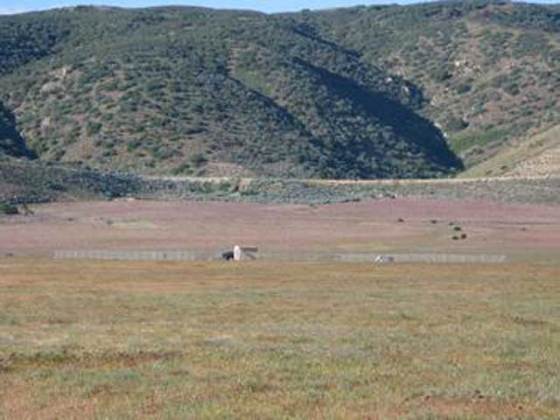Fish schooling inspires new ideas for vertical-axis wind turbines
 In the Los Angeles basin, the challenge of finding suitable space for large wind farms has prevented further progress in the use of wind energy. However, researcher John Dabiri, associate professor of aeronautics and bioengineering at California Institute of Technology (Caltech) and head of Caltech’s Biological Propulsion Laboratory, is using the bioinspiration from fish schooling in order to optimize the vertical-axis wind turbines.
In the Los Angeles basin, the challenge of finding suitable space for large wind farms has prevented further progress in the use of wind energy. However, researcher John Dabiri, associate professor of aeronautics and bioengineering at California Institute of Technology (Caltech) and head of Caltech’s Biological Propulsion Laboratory, is using the bioinspiration from fish schooling in order to optimize the vertical-axis wind turbines.
“I became inspired by observations of schooling fish, and the suggestion that there is constructive hydrodynamic interference between the wakes of neighboring fish,” says John Dabiri,. “It turns out that many of the same physical principles can be applied to the interaction of vertical-axis wind turbines.”
Vertical turbines, which are relatively new additions to the wind-energy landscape, have no propellers. Instead, they use vertical rotors which can be placed on smaller plots of land in a denser pattern. Caltech graduate students Robert Whittlesey and Sebastian Liska researched the use of vertical-axis turbines on small plots during a class research project supervised by Dabiri. Their results suggest that there may be substantial benefits to placing vertical-axis turbines in a strategic array.
In current wind farms, all of the turbines rotate in the same direction. But while studying the vortices left behind by fish swimming in a school, Dabiri noticed that some vortices rotated clockwise, while others rotated counter-clockwise. Dabiri therefore wants to examine whether alternating the rotation of vertical-axis turbines in close proximity will help improve efficiency. The second observation he made studying fish-and seen in Whittlesey and Liska’s simulation-was that the vortices formed a “staircase” pattern, which contrasts with current wind farms that place turbines neatly in rows.
Once they do identify the optimal placement, the researchers believe it may be possible to produce more than 10 times the amount of energy currently provided by a farm of horizontal turbines.
Dabiri has purchased two acres of land north of Los Angeles, where he is establishing the Caltech Field Laboratory for Optimized Wind Energy (FLOWE) on which he tests various configurations in order to find more efficient patterns. The pilot program at the site currently features six vertical turbines which provide a total power capacity of 15 kW.
The initial phase of the study will attempt to demonstrate which configuration of units will improve power output and performance relative to a horizontal-axis wind turbine farm with a similar sized plot of land. In the future, the researchers hope to achieve the transition to power-generation experiments in which the generated power can be put to use either locally or via a grid connection.










Wonderful invention. This will help save precious space for installing wind turbines. In India the installed Wind Capacity as on January 2010 stood at 10,950 MW. In a wind farm (Cluster of Wind Turbines) there will be Wind Park Effect. The “wind park effect” refers to the loss of output due to mutual interference between turbines. Wind farms have many turbines and each extracts some of the energy of the wind. Where land area is sufficient, turbines are spaced three to five rotor diameters apart perpendicular to the prevailing wind, and five to ten rotor diameters apart in the direction of the prevailing wind, to minimize efficiency loss. In India the rule followed is 7 times diameter of the rotor behind the wind turbines and 5 times between wind turbines.
There is Wake Effect also in a wind farm.
Since a wind turbine generates electricity from the energy in the wind, the wind leaving the turbine must have a lower energy content than the wind arriving in front of the turbine. A wind turbine will always cast a wind shade in the downwind direction.
In fact, there will be a wake behind the turbine, i.e. a long trail of wind which is quite turbulent and slowed down, when compared to the wind arriving in front of the turbine. (The expression wake is obviously derived from the wake behind a ship).
Unfortunately in India the Prime Windy areas are almost exhausted (For Example in Tamil Nadu (4565.63 MW, Maharashtra 2004.24MW,Gujarat 1666.61 MW, Rajasthan 845.5 MW). As such ways to be found to give permission to install Wind farms with stipulation of 5D and 3d instead of 7D and 5D. In USA they found an innovative way by installing Upwind Turbines (Where the Wind strikes the blades first) next to Downwind Turbine (where the wind strikes the tower first). Thus they saved precious land for installation of Wind Turbines.
One more option is putting a Wind Turbine in an area of 80 meters circle.
Also the 7D and 5 D rule need not be applicable in hilly areas.
Dr.A.Jagadeesh Nellore (AP), India
Wind Energy Expert
E-mail: anumakonda